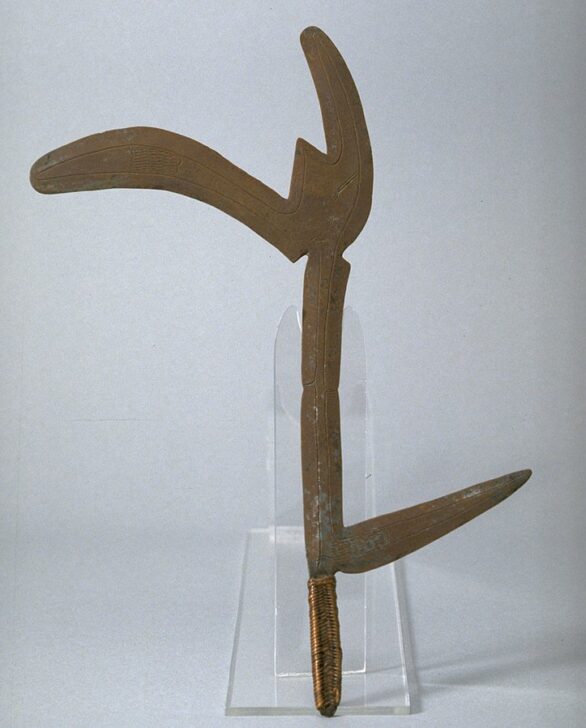Throwing-Knife
Zande

Description
Subject Matter:
The kpinga, or throwing-knife, was used as a missile during warfare by the Azande as well as by a wide variety of peoples who came under Zande influence in the areas of what is now the Democratic Republic of the Congo. It was considered mara ngbanga, or "court-metal", and distributed by a king or governor to men of particular companies in order to fight battles. A warrior would often carry two to four kpinga, which would hang on the imgasi, or metal disk, located on the inside of the shield carried in his right hand. A warrior would also carry two to four spears in his left hand. He would throw a kpinga only after exhausting his spears. Because it was mara ngbanga (court metal), a warrior would have to shout and publicly declare that he was going to throw a kpinga before doing so. In Evans-Pritchard's description of Azanda warfare, he describes it as an offense if one of the prince's knives is thrown without this preliminary declaration. The kpinga could be thrown in two ways: from a vertical position, with arm raised, or horizontally, from a low, bent position to produce a low trajectory for the missile. The kpinga had a physical as well as psychological impact. The multi-bladed form allows for at least one blade to hit the target when thrown. Additionally, the sight of several blades circling in the air was meant to frighten.
Variants of the kpinga were also used as mediums of exchange. Before the widespread introduction of scrap metal during the twentieth century, metal was an extremely valuable commodity and a token of great value. Iron that was produced locally for the purpose of exchange often took the form of modifed versions of utilitarian objects such as hoes, spears, or, in this case, throwing-knives. A kpinga made for warfare often had a sharp, polished finish and a form made for exchange often had a blackened or rusty surface.
Reference:
Spring, Christopher. African Arms and Armor. London, UK: British Museum Press, 1993.
Physical Description:
This multi-bladed weapon has four blades. Three blades radiate upward from the central shaft. The longest of these blades curves slightly downward and has a rounded, dull end. The second longest of these blades also has a rounded dull end and points upward. In between these blades is a short, sharp, triangular blade pointing upward. A fourth blade radiates outward (horizontally) from the bottom of the shaft, near the handle. It is a long, spear-like blade. The central shaft and blades are decorated with incisions that run along the edges, outlining the basic form of the weapon. The handle is wrapped in woven fiber.
Usage Rights:
If you are interested in using an image for a publication, please visit https://umma.umich.edu/request-image/ for more information and to fill out the online Image Rights and Reproductions Request Form.